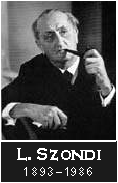













|
||||
 |
 |
|||
|
SZONDI AFFECT THEORY (Part of an article by Jean Mélon, in English and French The Szondi factors (e) and (hy) refer to affects of different qualities. But what is thus their meaning? The affect is a “Feeling Signal” (“Gefühlsignal”) which appears in the four vector fields in the form of:
The affect is coming from the inside (d´âme), is an intentional feeling and is object oriented: It is directed to something. Whereas mood (l`humeur) is a way of being; the affect aims at an object, a subject, a situation. The aversion is always an aversion against something; while mood is originating in the core-being. Szondi takes up the idea of Freud about the source of the affects: They might be incorporated in the psychic life as sediments of very old traumatic events (which show up) when the current situation reflects these old traumatic events. The mnemic-traces of the affects which were then called forward are reactivated by a kind of preformed reflex mechanism which starts “quasi-instinctual ”antiquated behaviors: Epilepsy: hypnoid state, stupor. Hysteria: tremors, convulsions (of movement), reddening. Which are then according to Szondi the various affects brought into play by the four factorial reactions of type (“e”) and (“hy”)? The factor épileptiforme (e) accumulates the forces of the brutal affects and discharge them in the form of a crisis: It is an asocial negative tendency (e-). But the factor (e) also conditions the socially positive tendency (e+):The inclination to be patient, to do justice, have piety, benevolence, etc… For example, one finds sometimes (e) in certain psychosomatic states where the rage is directed inside the body (auto-intoxication by hatred: “stammering” eruptions cutaneous, ulcers, hypertension, intestinal colitis, cerebral attacks, myocardial infarction, etc… French text. Les facteurs (e) et (hy) sont donc concernés par des affects de qualités différentes. Mais quelle est donc la théorie szondienne de l’affect? L’affect est un “signal de sentiment” (Gefühlsignal) qui reines dans les quatre champs vectoriels 1. affect S: Concupiscence avant et pendant la satisfaction sexuelle; 2. affect P: Rage qui signale l’envie de tuer; 3. affect Sch : le Courage et la Peur sont des affects qui se rapportent a l’acte de vouloir, a une prise de position du moi dans le sens de l’affirmation ou de la négation, avant ou après l’acte); L’affect est un “ d’âme”, Un sentiment intentionnel, objectalement orienté : il est dirigé ver chose. Alors que l’humeur est une manière d’etre-1à, l’affect vise un objet, un sujet, une situation. L’aversion est toujours aversion de quelque chose; l’humeur, elle, est originaire de l’etre-là. 4. Szondi reprend l’idée de Freud sur la source des affects ils seraient incorporés a la vie psychique a titre de sédiments d’événements traumatisants très anciens quand la situation actuelle fait écho a ces événements traumatiques anciens, les traces mnésiques des affects qu’ils ont suscités, sont réactivées par la mise en jeu d’un mécanisme réflexe organiquement préforme qui déclenche des comportements archaïques “quasi-instinctuels”
Epilepsie: état hypnoide, stupeur (faire le mort); Hysterie : tremblements, convulsions ( de mouvement), blémissement, rougissement ( tisme). Quels sont alors, selon Szondi, les différents affects mis en jeu par les quatre reactions factorielles de type “e” et “hy”? Le facteur épileptiforme (e) accumule les forces des affects brutaux et les décharge sous forme de crise : c’est la tendance asocialement negative (e-). Mais le facteur (e) conditionne également la tendance socialement positive (e+) : inclination a la patience, a la justice, a la piété, a la bienveillance, etc... Par exemple, on trouve parfois ( e- ) dans certains états psychosomatiques ou la rage est dirigée dans le corps (auto-intoxication par la haine : « begaiement » eruptions cutanées, ulcères, hypertension, colite intestinale, attaque cérébrale, infarctus du myocarde, etc... |
 |
 |
© 1996-2002 Leo Berlips, JP Berlips & Jens Berlips, Slavick Shibayev


